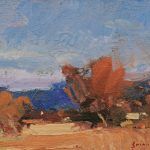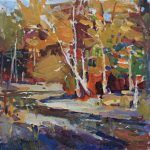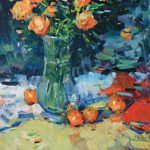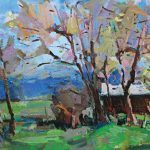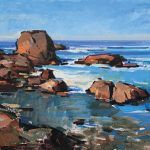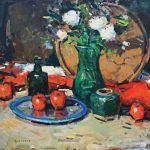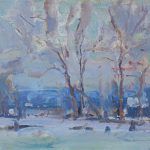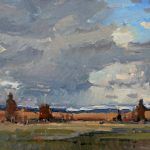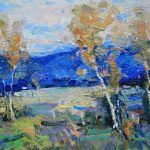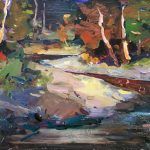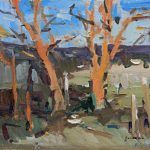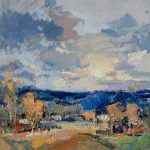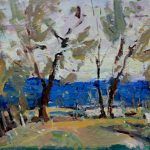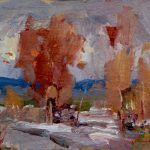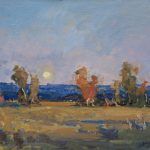Plein-air artist Eric Jacobsen thrives on the direct link between experiencing a scene and applying paint
By Gussie Fauntleroy
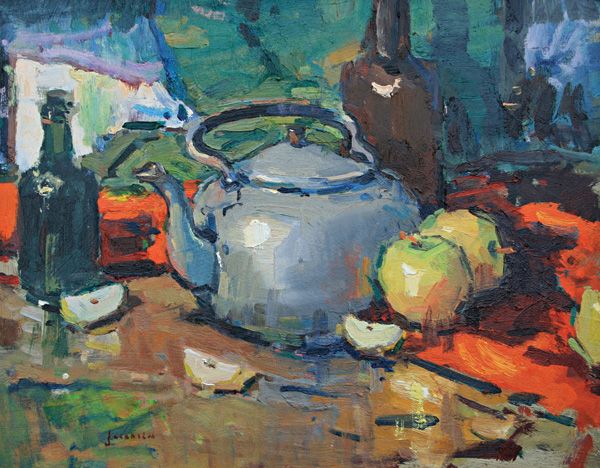
Eric Jacobsen, Tea Kettle, oil, 16 x 20.
This story was featured in the November 2016 issue of Southwest Art magazine. Get the Southwest Art November 2016 print issue or digital download now–then subscribe to Southwest Art and never miss another story.
There’s a reason Eric Jacobsen has taken home quite a few Artists’ Choice awards, along with other top honors, from plein-air painting events and exhibitions over the years. Fellow painters appreciate and respect what they see in his work. “I know I’m not blowing other artists away with my technique,” Jacobsen muses with characteristic humility. Yet here’s what painters tell him about why they’re drawn to his art: They see something in it that is fresh, spontaneous, uninhibited, free. They see loose, broad strokes that convey an immediate sense of mood, the elements, season, and time of day, which Jacobsen believes he can capture only by setting up an easel and painting on the spot. Which works out quite well, since outdoors is exactly where he most wants to spend his time.
Jacobsen’s penchant for painting on location also reflects his admiration for a long line of artists—landscape, figurative, or still-life—whose mastery was due, at least in part, to painting directly from life. In the studio beside the home he shares with his wife and four children on the outskirts of Prineville, in central Oregon, photos on the walls include one of a dapper Andrew Wyeth and a shot of New England painter Aldro Hibbard (1886-1972) standing before his easel in the snow. Nearby, Nicolai Fechin reproductions tell of Jacobsen’s love of Russian Impressionist art.
“These things remind me of my place in the historical context of painting,” the 50-year-old artist says. “They remind me that I’m doing something that others have done before, that I’m part of a tradition.” In particular, Jacobsen feels kinship with the landscape and maritime painters of New England, where he grew up and learned to paint. Just as importantly, he was profoundly influenced by time spent on the land and water itself, the rocky New England coast, the North Atlantic, and the woods, trails, and centuries-old farmland near his boyhood home.
- Eric Jacobsen, Evening, oil, 6 x 8.
- Eric Jacobsen, Morning Light, oil, 16 x 20.
- Eric Jacobsen, Roses, oil, 26 x 20.
Jacobsen was raised in the town of Easton, MA, south of Boston, the elder of two children of a civil engineer and a dental hygienist. He remembers himself as well rounded, a nice boy, good at sports but not a superstar. He loved drawing but didn’t know how to imagine it as a career. Years later he realized that his parents, who did not think of themselves as artists, were among his most important artistic influences growing up. His father, a birdwatcher, gardener, woodworker, and constantly curious nature lover, taught him to slow down and really see things. Eric’s mother’s creative touch came out in flower arranging; she entered an exhibition at the Boston Museum of Fine Arts in which participants created floral arrangements to match paintings by famous artists. “She has such a great eye,” her son says.
With no art classes in high school, Jacobsen entered Gordon College in Wenham, MA, as a pre-med student, following a family inclination toward medicine. But calculus was not his friend, and his interests soon turned instead to English, history, and art, the latter encouraged by professor and mentor Bruce Herman. Visiting Herman and his family at the instructor’s home one day, Jacobsen experienced his first glimpse of art as a possible vocation. “I remember to this day walking into his studio—the smell of the paint, the brushes and canvases all around. It was a workspace,” he says. “I remember falling in love with the idea of a profession in painting. The next part was figuring out how to get the skills.”
Living in Gloucester after graduating with a history degree, Jacobsen visited Walker Hancock, an acclaimed sculptor and former Monuments Man (who helped rescue and recover European art from the Nazis during World War II), then in his 80s. The young man asked Hancock where he should go to really study drawing and painting. Hancock’s reply: the Lyme Academy of Fine Arts in Old Lyme, CT. It was the perfect choice for Jacobsen. In those days the school attracted both young and older students, including midcareer artists, many there to study with renowned anatomy instructor Deane G. Keller. (Among Jacobsen’s fellow students was New England painter Nancy Guzik.) Lyme was structured in the manner of a French academic atelier, with nine hours of lessons each day in drawing, painting, and sculpting from life.
- Eric Jacobsen, Spring, oil, 20 x 26.
- Eric Jacobsen, The Turning Tide, oil, 18 x 24.
- Eric Jacobsen, White Roses, oil, 24 x 30.
While attending the academy, Jacobsen shared a house with Steve Gerhartz, brother of painter Dan Gerhartz. Steve and Eric frequently painted on location together, as did Eric and Lyme Academy painting instructor and friend Jerry Weiss. Also influential was instructor Dan Gheno, now a New York-based figurative painter. While almost all of Jacobsen’s courses focused on the figure, the young artist absorbed and applied those lessons to his genres of choice: landscape and still life. “Interestingly, all the folks I was rubbing elbows with painted from life as much as possible,” he says. “I’ve never wanted to paint from photos—I’m just not that interested in the process of painting that way.”
At the end of his four years at Lyme, Jacobsen received a Stobart Foundation Artist Fellowship, which provided a stipend for a year of painting and then an exhibition at the school’s gallery. Jacobsen’s show sold very well. “I realized that I might be able to make a living with this,” he says, smiling. A few years later he and his new wife, also a Lyme Academy graduate, drove west on their honeymoon, stopping to paint in national parks along the way. They spent two months at his uncle’s cabin near Vancouver and decided to move to the Northwest. They eventually settled in Prineville, close enough to paint both the high desert of central Oregon and the Pacific coast.
Jacobsen describes his career trajectory as a slow build, gradually becoming known regionally and then on a larger scale. Along the way, “lots of neat little things happened,” he says. Among them were having a solo exhibition at the Oregon Governor’s Mansion and taking part in—and winning awards at—plein-air shows. “I don’t know why I’ve been noticed as much as I have,” he says. Fellow artist Aimee Erickson of Portland, OR, who has painted alongside Jacobsen a number of times, has an idea: “When you watch him paint, he’s like a force of nature. Sometimes his hand moves so fast when he’s mixing and trying colors, you might think it’s random. But it’s just that he can think that fast,” she says. “He’s a very influential painter in the Northwest. What he’s doing with his painting is what a lot of us aspire to.”
- Eric Jacobsen, Winter Fog, oil, 12 x 16.
- Eric Jacobsen, Approaching Rain, oil, 15 x 24.
- Eric Jacobsen, Aspen, oil, 16 x 24.
What Jacobsen is doing, in his view, is immediately responding to the scene he’s taking in, rather than rendering it. “I’m satisfied if I get the mood down, and if I think that dialing in the
painting—adding more details—will lose the mood, I often don’t want to dial it in,” he says. In SPRING, for instance, the season’s exuberant energy and new life is effectively expressed through
vibrant hues, active brush strokes, and movement in the composition. “I always think of trees as figures, and I can hear one of my figure-drawing teachers telling me, ‘Exaggerate the pose!’ The tendency is to take the life out of it,” he says. “So I used a lot of staccato strokes and thick paint. I wanted the feeling of fresh spring and trees anticipating new leaves.” THE TURNING TIDE, on the other hand, takes a subject we may think of as restless and wild—a rocky seashore—and imbues it with quiet tranquility. “It goes back to the great New England painters who got a real feeling of the ocean,” Jacobsen says. “It’s not always about epic wave crashes on rock. This one is about the gentle turning of the tide.”
Jacobsen’s New England roots also influence his particular focus within a landscape. He notes that painters he admires frequently depict everyday images—an alleyway, or a boat up on blocks in a backyard—rather than monumental scenes. In the same way, he grew up appreciating the beauty of nature in New England’s relatively intimate scale. Even now, living in and painting the West, he finds himself drawn to something as small as a tree trunk illuminated by afternoon sun, for example, or an anonymous section of mountain stream. “I’m not against grand scenes,” he reflects, “but over the years, I’ve noticed I don’t gravitate to them.”
What does animate his creative flow, along with the compelling elements of composition and light, is the experience of feeling himself settle completely into the moment as he paints from life. “I want to be right there, interacting with the scene,” he says, adding that he aspires to the same approach of being present in everything he does. “I don’t want any rehearsals in my life. I want to be honest and authentic in any situation. It’s difficult, but we can train ourselves to do it,” he says. “I think you’re giving people your best possible work if you’re painting it from your heart.”
- Eric Jacobsen, Banks of the Sol Duc, oil, 16 x 24.
- Eric Jacobsen, Barren Trees, oil, 11 x 14.
- Eric Jacobsen, Clouds and Rolling Hills, oil, 30 x 32.
- Eric Jacobsen, Locust Trees, oil, 16 x 24.
- Eric Jacobsen, Melting Snow, oil, 11 x 14.
- Eric Jacobsen, Yellow Moon, oil, 16 x 26.
representation
Art on the Boulevard, Vancouver, WA; Evergreen Fine Art, Evergreen, CO; Ingram Art & Antiques, Wiscasset, ME; Michael Parsons Fine Art, Portland, OR; Mockingbird Gallery, Bend, OR; Gallery 89, Steamboat Springs, CO; Phinney Gallery of Fine Art, Joseph, OR.
This story was featured in the November 2016 issue of Southwest Art magazine. Get the Southwest Art November 2016 print issue or digital download now–then subscribe to Southwest Art and never miss another story.
MORE RESOURCES FOR ART COLLECTORS & ENTHUSIASTS
• Subscribe to Southwest Art magazine
• Learn how to paint & how to draw with downloads, books, videos & more from North Light Shop
• Sign up for your Southwest Art email newsletter & download a FREE ebook






